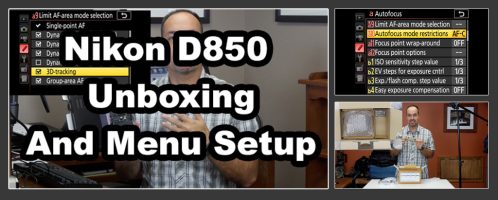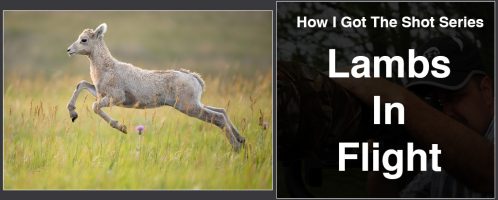Exposure compensation – I don’t think there’s another exposure control that causes more confusion. In fact, I think most people are in for a surprise or two when they watch this one!
In this video, we’ll explore every aspect of exposure compensation and knock confusion to the curb. We’ll discuss what it is, what it does, why you need it, what exposure control(s) it adjusts, what to do when it doesn’t work, and when it’s a better choice than manual mode.
And, most importantly, we’ll talk extensively about how to recognize scenes where you’ll need it with tons of examples.
Wanna play that exposure compensation dial like a Mozart played the piano? You gotta check out the video!
.
Metering Mode Note
I’ve had a lot of comments asking if the advice in the video is just for matrix metering or if it applies to other metering patterns as well. Basically, if something like Spot Metering would fix the problem.
The meter will work based on the guidelines in this video regardless of the metering pattern. In fact, Spot and Center Weighted are more prone to wild swings than matrix metering is.
Both Spot and Center Weighted meters are 100% trying to make whatever is under them middle tone gray. Matrix / evaluative metering does as well, but it also takes a variety of other factors into account and isn’t as easily fooled by some subjects. (I cover these concepts extensively in my exposure / metering book.)
For one quick example, let’s say I spot metered off the polar bear you saw in the video. Since the polar bear is white(ish), the spot meter would still underexpose it. If it were a black bear, we’re looking at a severe overexposure with a spot meter. For a complete overview of how the spot meter works (and some dramatic examples to illustrate these concepts) check out the Spot Metering video I did a couple months back.
Again, not to beat a dead horse here, but if you find some of this (or any of this) confusing, you owe it to yourself to grab that exposure and metering book. Most photographers never really get this down and struggle with it constantly. For less than the price of a lunch date you’ll never get tripped up by your meter again.
PS – If you enjoyed this post, I think you’ll REALLY like my e-books and video workshops! Thousands of pages and hours of videos filled with tips, tricks, and techniques – all my best content! Check ’em out – click here (hey, it’s free to look).




I thought the video was completely correct and liked that above our comments you talked about the different metering modes and effect under each meter type. However as I watched the video it seemed nearly or all cases you were referring to matrix metering, why? because you would refer to the meter looking the entire frame and of course spot and center don’t. This is where I was looking for you to mention you were using matrix metering. My guess is a lot of inexperienced folks didn’t really catch that and may be tripped up when using one of the… Read more »
The main reason I didn’t mention it was because spot metering can just as easily require exposure compensation. That’s why I put the metering note above with the spot meter video 🙂
Thanks for the excellent presentation which is clear and informative. I didn’t mind listening to the video again even I do have the Nikon exposure e-book. The only thing I am not completely sure about was calling the meter making a “mistake” when the scene was not in mid-tone. It might give some people an impression that the light meter is prone to making errors (electronic/mechanical) while in fact is doing a “perfect” job it’s designed for, but just may not be what the photographer wanted. Unfortunately, I can’t come up with something better.
That was great information Steve, I have read my book serval times it is great help, but I sure in joy your video I get a lot out of them . Thanks Dale
Steve, excellent video on Exposure Compensation. Exposure compensation is what I think is one of the best advantages of shooting with a Nikon Z mirrorless and a Z lens, with the ability to adjust exposure compensation while viewing both the actual exposure and histogram through the viewfinder. I suffer from loss of low light vision so the EVF has made all the difference as I was having problems seeing through my DSLR viewfinder. I’ve appreciated your Nikon Z book and several other videos and am considering your Nikon Exposure Meeting book, but am concerned that it may be more DSLR… Read more »
Thanks for the kind words. The exposure book broadly applies to most cameras, regardless of brand, it’s just that Nikon is used for the examples and the settings are all Nikon settings, so it’s a Nikon book 🙂 It does however apply to the Z cameras as well.
Great video, thanks. I see your comments re spot and center weighted metering. But wouldn’t spot metering be helpful with white animal with dark background? Just increase EC by a stop and forget about the background.
Good job as usual. I look forward to your well produced and informative videos.
I just watched your video on Exposure Compensation and was wondering if the Metering Mode makes a difference? I think it would because of where each mode takes its reading. Is there on mode in particular that you would suggest? Thank you
Other metering modes will just as readily miss the exposure. They all look at middle tone – in fact, matrix is the lest likely to go really far astray.
Thanks for another great video, Steve. I have both your exposure book and the focus book. I have learned a lot. But I have a “dumb” question. If I don’t really have a good enough eye yet to judge what is 2/3 stop or 1/3 stop over or under exposed and I shoot in raw, does it matter if don’t do exposure compensation and just correct in LR, assuming I check for blinkies. Put another way, what is minimum that I can be off in correcting with exposure comp and still fix it in LR without too much noise in… Read more »
If you’re shooting RAW, it’s not a problem as long as you don’t blow the highlights. Most cameras are pretty good at shadow recovery, but once highlights are gone, they are gone. How much you can recover varies by camera, but most current Nikons can go 3 stops easy (not the D5/6 though). Just keep in mind that for every stop you brighten in post, you add a stop of noise.
Excellent explanation, thanks. Where does “expose to the right” fit into this?
You can use exposure comp to get your exposure just to the edge of clipping for ETTR. However, there’s very little reason to use ETTR with today’s sensors unless you are at base ISO and want the ability to really pull shadows.
Another great video, Steve I just installed Lightrooms support for z6 II, and the NEF files for AstroPhotography are awful. I was so impressed with how clean the jpg files were at ISO 10,000 that I couldn’t wait to get the RAW files, boy was I disappointed, they are so noisey I can not believe it. Do you think Adobe screwed up the RAW file, or is it just Nikon is doing such a good job in Camera processing the jpg files. I would like to hear your thoughts.
Thanks,
Dick Paige
Hi, Maybe you can try other raw converter to make a comparison.There are trials to evaluate many of them. Or just fiddle with sliders like shadow or black … just guessing or even try to make a color profile with a color checker.
The profiles in lightroom can be less than perfect when first launching support for a new camera
Nikon is applying noise reduction to the jpegs – you can probably get a similar result in Lightroom with the noise reduction sliders. Although Nikon is really good at applying noise reduction! You could also try something like Topaz Denoise too.
Brilliant. Thank you, Steve. You changed my photographer’s life in two steps. 1. Manual with auoto ISO 2. Back button autofocus. I still want to learn more. Miss some information about how to use flash with auto ISO and TTL, seems not working.
Brilliant explanations like every time by Steve. The examples are great too! of course i have got the book of metering for Nikon, because I shoot with a d5 and i am not ready at all to change for mirorrless ! . Thank you for all Steve.
Alternatively, just kill auto ISO if you are capping out in Manual mode because by the time you’ve gone through all the possible adjustments to correct for it the subject has long since gone!
The trick with M + Auto ISO is to set the maximum ISO you’re willing to tolerate from the get-go. That way, there’s never any need to go into the Auto ISO menu to adjust. However, I wanted to make a point in this video that the capping problem is often due to a low ISO getting set. Normally, you’d have your max ISO in there and if you hit the cap, you’d just use shutter speed and F/stop to adjust away from that cap and never mess with the Auto ISO menu at all. In that case, staying in… Read more »
I hope I’m not in the minority here, but as far as I’m concern you can never go on too long. The more information the better.
When I got to the section in your book where you used the three cards it all made sense. At first I had to keep reminding myself when looking at the subject and the exposure needed, dark-under, light-over. Now it is automatic.
So once again, thanks.
Another great explanation Steve.
Great explanation as usual and with a lot of good examples
I shoot RAW, D850/500 so most times I can pull the shadows if needed. I only use Manula/auto ISO, but hardest is when a bird is flying from sun to shadow, any tips on that, usally have a second or 2 max to react,any tips on that scenario 🙂 Thanks
That’s about the hardest situation you can run into, especially if the backgrounds are dark. What I do is sort of a compromise, but it works. I set a manual exposure so I don’t clip highlights no matter where the bird is (this is assuming that you can do that – like when a bird is going back and forth from a nest), then I fire away. I’ll have some underexposed shots in the shadow areas that I can bring back in Lightroom. Thankfully, the D850 and even the D500 (to an extent) are ISO invariant to a point, so,… Read more »
Heh Steve and Shanti this is my constant dilemma. “I trying to not clip my egret wings and neck and I don’t have very much time to start to dial in compensation usually 2/3 of a stop +, shooting against a bright sky” and I do use spot metering most of the time on my 850 and 500 with 500 PF at f5.6 and usually 1/1000 sec is there a quick way to mechanically do this setting change or is it just practice as neither of these bodies have user configurable buttons like my old 750? I hope this make… Read more »
Another great video Steve. One question, why not just use spot metering? I know some people that use that all the time. I’m more of an exposure compensation sort myself.
Thanks! For spot metering – you could and I do sometimes 🙂
However, spot metering with autoexposure isn’t immune to errors. If you spot meter on the polar bear in this video, it’ll underexpose just as readily as the matrix meter will 🙂 (I do have a video on spot metering too).
Where do we find this Spot Metering Video, Steve.
Always great stuff, now I’m confused at to whether to continue using Spot Metering
Here ya go:
https://backcountrygallery.com/spot-metering-crash-course/
Great question!